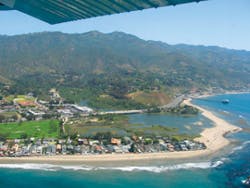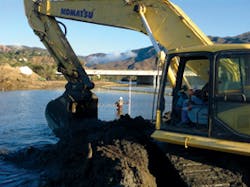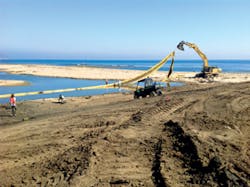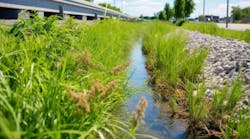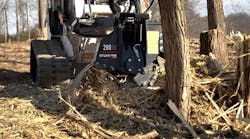Long before the job finally got under way in June 2012, the restoration of Malibu Lagoon, a 31-acre shallow water embayment formed where Malibu Creek empties into the Pacific Ocean, had accumulated a reputation as of one of California’s most ecologically sensitive and politically contentious construction projects.
Ecologically sensitive, because the object was to restore ecological balance to one of the state’s last naturally functioning lagoons; contentious, because opponents claimed the design was flawed and heavy equipment would destroy a local landmark and habitat for two endangered fishes and an estimated 291 species of birds. Local and national media gave the project extensive coverage as Malibu locals, environmentalists, and surfers argued with each other and among themselves. But at the end of the day all this controversy boiled down to moving 88,000 cubic yards of dirt to excavate new channels for water circulation and create a series of small islands to provide nesting and resting spots for the birds. The 12-acre site was constrained on one side by Malibu Colony, a high-end, gated residential community favored by the entertainment industry. It was bordered on the west by a private a golf course, and to the north by the four lanes of Pacific Coast Highway.
Background
The existing lagoon occupies only a small portion of its historic area. A significant portion of the once low-lying tidal areas near the mouth of Malibu Creek was filled in the 1940s and 50s, and in the 1970s the site was completely filled to create two baseball fields. Over the years the lagoon has also been used as a dumpsite by, among others, the California Department of Transportation (Caltrans) when it reconfigured Pacific Coast Highway. In 1983 the state Department of Parks and Recreation initiated a restoration effort that involved the excavation of three channels into the filled area to help restore the western arm of the lagoon to its original function. The project included seeding with salt marsh plants and construction of a series of bridges to facilitate public access to the lagoon and the beach.
However well intentioned, the design trapped debris and polluted water in the lagoon’s interior reaches. To remedy this situation, the 2012 restoration called for a new main channel to increase tidal flow when the natural sand berm at the mouth of the lagoon is breached and increase wind-driven circulation when the berm is closed. The design also called for removal of the bridges, to be replaced with reconfigured paths, and the installation of educational exhibits.
New channels had to be excavated for water circulation, and a series of small islands were to be created.
The general contractor on the project was Southern California-based Ford, E.C Inc., which subcontracted the excavation work to PBA Ltd., a Carlsbad, CA-based firm specializing in coastal and lagoon work, which is turn brought in Roberts General Engineering, also lagoon restoration specialists. The schedule called for an October 15, 2012, complete date, later extended to October 31, when native plant restoration would begin. Work began in earnest in the first week of June under permits from the US Army Corp of Engineers, the California Coastal Commission, the Los Angeles Regional Water Quality Control Board (which issued the NPDES permit), the state water-quality control board, the US Fish and Wildlife Service, and Los Angeles County. Equipment was brought onsite under a police escort, with protestors at the gate, and police protection continued for the first two months of the project.
According to project supervisor Amir Amini, the plan was to clear existing vegetation, construct a berm to separate the areas to be graded from the main body of the lagoon, and dewater. Prior to the start of the project, state interns and volunteers trapped and removed over 100 land mammals. Approximately 100 more were added during construction from lizards to salt marsh voles. Monitors were assigned to each piece of heavy equipment so any remaining animals could be trapped and removed. In addition, a Chumash Native American monitor was required to be present during mass excavation and archeological monitors were also onsite.
Before dewatering could begin, any existing populations of the endangered steelhead trout and the tidewater goby had to be removed. All water disposed of from the site had to be treated to Title 22 standards (basically drinking water quality) before it could be discharged into the ocean. Regulations aimed at keeping sediment out of the main body of the lagoon required the installation of turbidity curtains to isolate the construction area.
Construction of the dewatering berm was complicated when the Coastal Commission issued the injunction that water in the construction site could not be cut off from the main lagoon for any longer than 48 hours because temperatures would rise, endangering the fish. “We couldn’t close off the berm because of the fish, and if we didn’t close off the site, we couldn’t dewater,” says Amini. “And if we couldn’t dewater, we couldn’t work. We talked about it and decided to take it in sections, to close a section that we could seine for fish and dewater in 48 hours, then proceed to another section, until the whole site was done.” Before this operation could begin, however, the natural sand berm separating the lagoon from the ocean opened, drawing water from the area to be excavated. The site was fished and the construction dike quickly built in the two-week window between the opening and closing of the natural berm.
Grading was completed on time, and areas were prepared for underwater planting.
One initial challenge of the project was the large number of non-construction monitors on site. “Usually the excavators go in, do their job and move on,” says Amini. “Because of all the monitors each piece of equipment had around it, the operators had to work much slower, both for the safety of the people on the ground and because of what the monitors were looking for.”
“It was rough the first two weeks,” says Lloyd Webb, president of Roberts Engineering. “If we ran into any kind of animal, we had to stop while they trapped it. When we cleared brush, we couldn’t just shove it out of the way over to the trucks to be loaded. Volunteers walked ahead of us looking for signs of any animals. After we cleared an area we had to pick up the pile and set it behind us so the monitors could look under it again to make sure we hadn’t picked up anything.” Gradually a procedure evolved where Webb informed state managers of where crews would be working ahead of time and the state would arrange for enough staff and volunteer monitors that there would be no holdups. “It took about two weeks,” says Amini, “but both groups gradually developed an appreciation for what the other was doing,” Not to mention that the equipment operators had a bird’s eye view of the animals the volunteers were looking for.
Mammals were one thing, birds another. When the project started, there were five or six nesting birds on the site, says Ray Files of PBA Ltd., the nests protected by restrictions that limited noise levels to no more than 65 decibels within egg laying areas. According to Mark Abramson, senior watershed advisor for the Santa Monica Bay Commission and liaison between the construction crew and the various permitting agencies, the excavator operators determined that if they worked the equipment with the exhaust manifold away from the nest, there was no problem meeting the noise level standard. Bulldozers were too loud and couldn’t be used around the nests. “The birds were less disturbed by equipment than by the monitors rushing forward with sound monitors.” In all, Abramson says, 20 nests incubated, hatched, and fledged offspring during the course of the project.
“These things definitely slowed us down,” says Webb. “But we knew it was in the specs and we planned on it. The state did a great job with manning the project, so if we told them we would have a crew in a particular place the next day, they had their people there.” After work had been under way for two weeks, the Army Corps of Engineers expressed concern that a large portion of the site was potential habitat for the snowy plover, an endangered bird species. Amini restricted access to that part of job completely until the state, Coastal Commission, and the Army Corps resolved the issue. The shutdown lasted a month.
Water Management
Biological concerns aside, Amini and Files and Webb agreed that water management was the job’s major challenge. Groundwater was entering the site at the rate of approximately 2,000 gallons a minute, but the treatment plant could only handle 600 gallons a minute. “We had to remove all this dirt, reshape the whole thing per the drawings, and we had 2,000 gallons of water coming in that had to be treated before we could release it,” says Amini. “Ordinarily you would just pump the whole thing out to the ocean, which would leave you with a relatively simple grading job. But because we were operating in a closed environment, the groundwater entering the site built up and we had to have somewhere to store it until it could be pumped to the treatment plant.
“What we came up with was to divide the area into two sections. We built another dike in the middle of the site and used one area as a catch basin for water storage while we worked the other side. We caught up in weekends, when we lowered the catch basin down so we could started pumping again during the week.”
“The pumping was critical,” says Files. “If we didn’t pump, there was no way the operators could have done the work. You can’t grade per the stakes and drawings if you’re in water. The pumps had to be specially built with quarter-inch grates. Then the state installed sixteenth-inch nets to protect mosquito fish.
“The water pumping was a nightmare, days and days and days, 24 and seven. All the dirt we moved onsite was moved in wet conditions. We had a lot of equipment in a small space because we had to push extremely fast in a very short period of time. At high tide the water table inside the project would fluctuate 6 or 8 inches. If you’re already in 2 feet of water and you add another 6 inches, that would stop you. Our crews had to work quickly. We called it the dance. Each operator had a grade checker with him. When he got out there in the water, he had to do the finish grading at the same time, and it better be right. There was no second chance, because in an hour it was going to be underwater.
Stuck in the Mud
This was a difficult lagoon to do,” says Wood, “because there wasn’t a lot of sand for stability. Instead there was a lot of silt and a lot of black muck, particularly in the old creek channel. It had been silted in for 100 years, and machines couldn’t get through it. In other areas of the site you’d get a sand layer at about 4 or 5 feet that was hard and stable. In areas where we had to get into the silt, we had to bring sand over, bridge a road out to it, excavate the silt out and then excavate the sand back out.”
“No landfill is going to take that kind of mud,” says Files. “So at any one time we had 5 acres set aside for a drying area. We ran this drying operation for the entire project. We’d spread the muck and turn it and keep turning it just like a compost pile.” All dirt excavated onsite had to be tested for toxicity. None of it was found to be toxic, but crews dug up a lot of debris from a site protestors had insisted was pristine-slabs of concrete and asphalt, railroad ties, old pipes and water lines, and concrete and wood pilings. “We separated it all out, made a clean pile of concrete debris, and since none of this was known to be onsite, the state stepped up and removed it.”
With time lost to wildlife regulations, crews worked overtime, and the state picked up the tab. Grading was completed on time and crews also helped prepare areas for underwater planting. “In coastal work you cannot not meet your deadlines,” says Files, “because there are too many natural variables you have to work around.” In this case the deadline was set to avoid the rainy season.
“It was tough, tough work,” says Amini, “especially given the protests. The first two months, I couldn’t walk down the street easily. It was verbal harassment, but it was aggressive and really too much sometimes. They had the camera on you and were saying whatever they wanted to and waiting for you to snap. The project was also unique because of the politics and the different agencies that were involved. We developed a procedure where if the construction crew got tied up in an issue that involved regulation or they were stopped because of one of the regulations or constraints, we took it to the state, which acted as the go-between with the agency involved. And whenever we were stopped for something, I made sure we got the okay in writing to go back to work.”